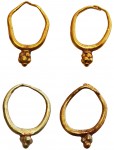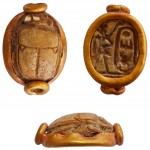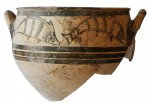 Archaeologists from the University of Gothenburg have unearthed an exceptionally rich grave dating to 1500-1400 B.C. near the Bronze Age city of Hala Sultan Tekke in eastern Cyprus, one of the richest from the period ever found in Cyprus. The grave was discovered after a geophysical survey pinpointed nearly 100 underground pits in an area where farming had caused significant erosion. Most of the pits were wells averaging three feet in diameter. One of them was significantly larger at 13 by 10 feet. Excavation found the large pit was a family tomb which held the remains of eight children between five and 10 years old and nine adults, the oldest of whom was only 40 at the time of death. An offering pit was found adjacent to the tomb.
Archaeologists from the University of Gothenburg have unearthed an exceptionally rich grave dating to 1500-1400 B.C. near the Bronze Age city of Hala Sultan Tekke in eastern Cyprus, one of the richest from the period ever found in Cyprus. The grave was discovered after a geophysical survey pinpointed nearly 100 underground pits in an area where farming had caused significant erosion. Most of the pits were wells averaging three feet in diameter. One of them was significantly larger at 13 by 10 feet. Excavation found the large pit was a family tomb which held the remains of eight children between five and 10 years old and nine adults, the oldest of whom was only 40 at the time of death. An offering pit was found adjacent to the tomb.
 Inside the grave and offering pit, archaeologists found 140 complete ceramic vessels, gold jewelry including a diadem, earrings and beads, gold-mounted stone scarabs, gemstones, a bronze dagger and five cylinder seals. Some of the objects were made locally; some were made in Syria, Mesopotamia or Egypt. Most of the ceramics are elaborately decorated. Subjects painted on the vessels include people in a two-horse chariot, religious iconography, animals and a woman wearing elegant Minoan clothing. The ceramic vases were largely imported from Greece, Crete and Anatolia.
Inside the grave and offering pit, archaeologists found 140 complete ceramic vessels, gold jewelry including a diadem, earrings and beads, gold-mounted stone scarabs, gemstones, a bronze dagger and five cylinder seals. Some of the objects were made locally; some were made in Syria, Mesopotamia or Egypt. Most of the ceramics are elaborately decorated. Subjects painted on the vessels include people in a two-horse chariot, religious iconography, animals and a woman wearing elegant Minoan clothing. The ceramic vases were largely imported from Greece, Crete and Anatolia.
“The pottery carries a lot of archaeological information. There were for example high-class Mycenaean imports, meaning pottery from Greece, dated to 1500–1300 BC. The motif of the woman, possibly a goddess, is Minoan, which means it is from Crete, but the vase was manufactured in Greece. Back in those days, Crete was becoming a Greek ‘colony’,” says [University of Gothenburg professor of Cypriote archaeology Peter] Fischer.
According to Fischer, the painting of the woman’s dress is highly advanced and shows how wealthy women dressed around this time. The motif can also be found on frescos for example in the Palace of Knossos in Heraklion, Crete.
 The grave goods also feature important objects from Egypt, like the gold-mounted scarabs. One of the stone scarabs is inscribed with the hieroglyphs for ‘men-kheper-re’ and the figure of a pharaoh. It refers to 18th Dynasty pharaoh Thutmose III (1479–1425 BC), whose successful wars of conquest expanded Egypt’s empire to its largest size, absorbing Syria and much of Mesopotamia.
The grave goods also feature important objects from Egypt, like the gold-mounted scarabs. One of the stone scarabs is inscribed with the hieroglyphs for ‘men-kheper-re’ and the figure of a pharaoh. It refers to 18th Dynasty pharaoh Thutmose III (1479–1425 BC), whose successful wars of conquest expanded Egypt’s empire to its largest size, absorbing Syria and much of Mesopotamia.
 Hala Sultan Tekke was one of the largest cities in the Late Bronze Age. It was inhabited from 1600 through 1150 B.C. and radar surveys have found that at its peak it was up to 50 hectares in area. The prosperous city benefited from extensive trade connections that reached as far as Sweden. The great number and variety of artifacts found in the tomb didn’t travel quite that far, but they attest to the availability of luxury imports in the Late Bronze Age city.
Hala Sultan Tekke was one of the largest cities in the Late Bronze Age. It was inhabited from 1600 through 1150 B.C. and radar surveys have found that at its peak it was up to 50 hectares in area. The prosperous city benefited from extensive trade connections that reached as far as Sweden. The great number and variety of artifacts found in the tomb didn’t travel quite that far, but they attest to the availability of luxury imports in the Late Bronze Age city.
 The archaeological team found evidence in the city proper of textile production and purple dying on an industrial scale. Purple dye was rare, expensive and of regal cachet. With purple textiles to trade, Bronze Age Hala Sultan Tekke could afford the best goods Egypt, Syria, Mesopotamia, Greece, Anatolia and Crete had to offer.
The archaeological team found evidence in the city proper of textile production and purple dying on an industrial scale. Purple dye was rare, expensive and of regal cachet. With purple textiles to trade, Bronze Age Hala Sultan Tekke could afford the best goods Egypt, Syria, Mesopotamia, Greece, Anatolia and Crete had to offer.
The tomb was found next to an older neighborhood of the city which has yet to be fully explored. Excavations are over for the season, but the team will return next year to explore more of the area near the tomb before agricultural activity destroy the site.